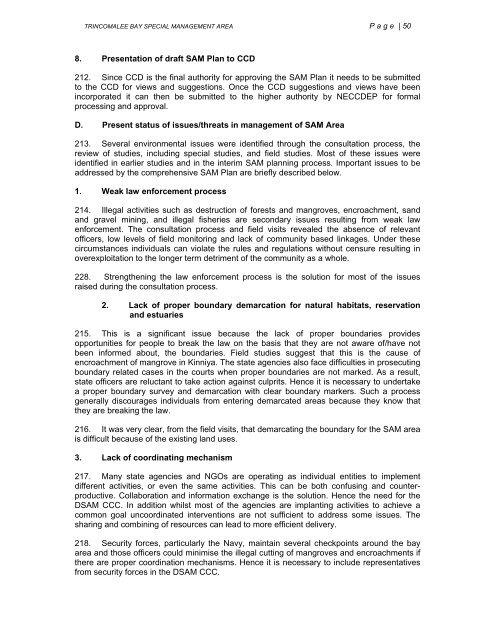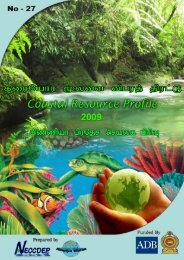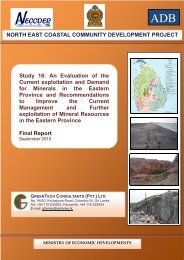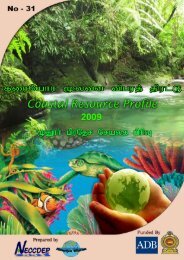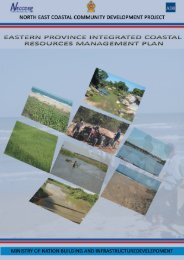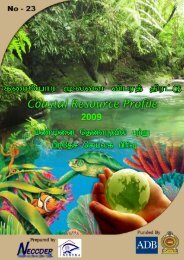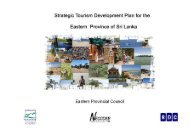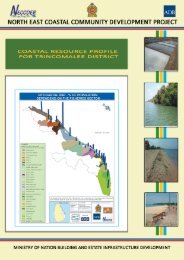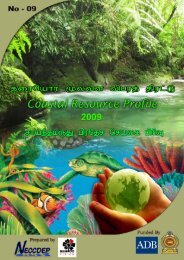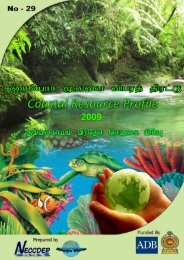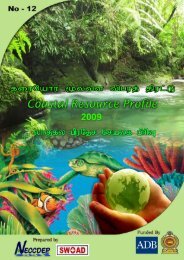Untitled - Neccdep.com
Untitled - Neccdep.com
Untitled - Neccdep.com
You also want an ePaper? Increase the reach of your titles
YUMPU automatically turns print PDFs into web optimized ePapers that Google loves.
TRINCOMALEE BAY SPECIAL MANAGEMENT AREA Page | 50<br />
8. Presentation of draft SAM Plan to CCD<br />
212. Since CCD is the final authority for approving the SAM Plan it needs to be submitted<br />
to the CCD for views and suggestions. Once the CCD suggestions and views have been<br />
incorporated it can then be submitted to the higher authority by NECCDEP for formal<br />
processing and approval.<br />
D. Present status of issues/threats in management of SAM Area<br />
213. Several environmental issues were identified through the consultation process, the<br />
review of studies, including special studies, and field studies. Most of these issues were<br />
identified in earlier studies and in the interim SAM planning process. Important issues to be<br />
addressed by the <strong>com</strong>prehensive SAM Plan are briefly described below.<br />
1. Weak law enforcement process<br />
214. Illegal activities such as destruction of forests and mangroves, encroachment, sand<br />
and gravel mining, and illegal fisheries are secondary issues resulting from weak law<br />
enforcement. The consultation process and field visits revealed the absence of relevant<br />
officers, low levels of field monitoring and lack of <strong>com</strong>munity based linkages. Under these<br />
circumstances individuals can violate the rules and regulations without censure resulting in<br />
overexploitation to the longer term detriment of the <strong>com</strong>munity as a whole.<br />
228. Strengthening the law enforcement process is the solution for most of the issues<br />
raised during the consultation process.<br />
2. Lack of proper boundary demarcation for natural habitats, reservation<br />
and estuaries<br />
215. This is a significant issue because the lack of proper boundaries provides<br />
opportunities for people to break the law on the basis that they are not aware of/have not<br />
been informed about, the boundaries. Field studies suggest that this is the cause of<br />
encroachment of mangrove in Kinniya. The state agencies also face difficulties in prosecuting<br />
boundary related cases in the courts when proper boundaries are not marked. As a result,<br />
state officers are reluctant to take action against culprits. Hence it is necessary to undertake<br />
a proper boundary survey and demarcation with clear boundary markers. Such a process<br />
generally discourages individuals from entering demarcated areas because they know that<br />
they are breaking the law.<br />
216. It was very clear, from the field visits, that demarcating the boundary for the SAM area<br />
is difficult because of the existing land uses.<br />
3. Lack of coordinating mechanism<br />
217. Many state agencies and NGOs are operating as individual entities to implement<br />
different activities, or even the same activities. This can be both confusing and counterproductive.<br />
Collaboration and information exchange is the solution. Hence the need for the<br />
DSAM CCC. In addition whilst most of the agencies are implanting activities to achieve a<br />
<strong>com</strong>mon goal uncoordinated interventions are not sufficient to address some issues. The<br />
sharing and <strong>com</strong>bining of resources can lead to more efficient delivery.<br />
218. Security forces, particularly the Navy, maintain several checkpoints around the bay<br />
area and those officers could minimise the illegal cutting of mangroves and encroachments if<br />
there are proper coordination mechanisms. Hence it is necessary to include representatives<br />
from security forces in the DSAM CCC.


